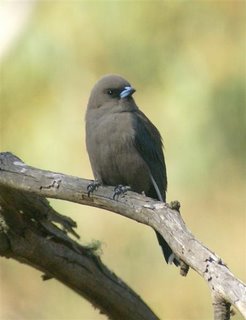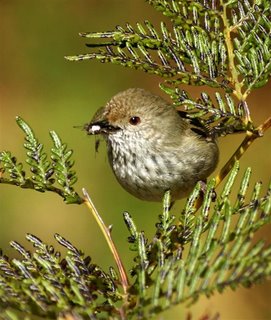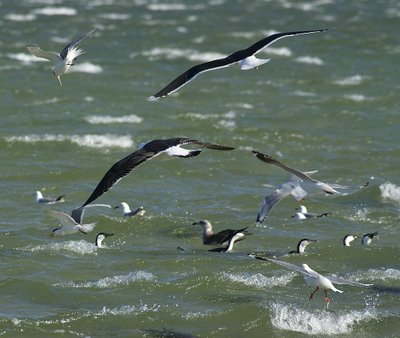
It's all happening out there! A recent visit to the Peter Murrell Reserve at Kingston, on one of the few still days, produced a rash of sightings of breeding birds. From the car park, I made my customary walk rould the 'pond', looking out for the Tawny Frogmouth that bred there last year. Much to my surprise, there it was, still using the same site and I even found it without the usual 15 minute search. Further down the track, passing the Spotted Pardalotes, to and froing from their nest hole alongside the track, and the Grey Shrike-thrushes seeking insects from under the bark, I heard the unmistakeable sound of Dusky Woodswallows. Stopping to try to photograph them, I watched as 2 birds displayed and chased each other,

watched by 2 presumed females woodswallows, one shown at left. While I was engaged in that, I became aware of a Brown Thornbill close by (photo at right), carrying food, (I think it's a mosquito). I was obviously close to the nest. Quick shot, and away. As I moved back onto the track, I disturbed a Dusky Robin from it's nest behind the bark of a large eucalypt only about a metre f

rom the track. On the return leg, I passed Fortyspots, carrying food. Nearing the car park, I watched and photographed a displaying Shining Bronze-Cuckoo (photo at bottom). This is about the fourth or fifth 'shining' I've photographed displaying in the last month, having never witnessed them displaying before! I have spent a deal of time watching them though. I'm coming to the conclusion that they travel in pairs--probably not unlikely, I would guess.
I

watched as a bronze-cuckoo called, getting a reaction from a pair of Brown Thornbills. In an instant, the cuckoo dived from its' perch into the ferns where the Browns presumably had their nest. The cuckoo spent around five minutes in among the ferns, presumably locating the 'Browns' nest, before flying off. I was torn between searching for the nest or leaving them in peace, before deciding on the latter. An action packed few hours
 On a day that looked less than promising, I made an early morning visit to Pipeclay Lagoon. By the oyster sheds there are 2 pairs of Pied Oystercatchers that have become very tolerant of human presence, and one pair (pictured) is regularly fed oysters by the staff there. I'm sure I could make some remark about the aphrodisiac properties of oysters, but as I stopped the car to observe this pair, as you can see, they copulated. I have always thought that the shots that I've seen of Oystercatchers copulating,
On a day that looked less than promising, I made an early morning visit to Pipeclay Lagoon. By the oyster sheds there are 2 pairs of Pied Oystercatchers that have become very tolerant of human presence, and one pair (pictured) is regularly fed oysters by the staff there. I'm sure I could make some remark about the aphrodisiac properties of oysters, but as I stopped the car to observe this pair, as you can see, they copulated. I have always thought that the shots that I've seen of Oystercatchers copulating,  must have been the result of many hours watching and waiting! Maybe not. With rain threatening, I decided to drive on to South Arm, and walked through the dunes to Calvert's Beach. As I reached the top of the dune, I saw below me, the seal on the waters' edge that is pictured here. I assume it's an Australian Fur Seal, but perhaps there's someone reading this who can confirm that. A more rewarding morning than appeared likely.
must have been the result of many hours watching and waiting! Maybe not. With rain threatening, I decided to drive on to South Arm, and walked through the dunes to Calvert's Beach. As I reached the top of the dune, I saw below me, the seal on the waters' edge that is pictured here. I assume it's an Australian Fur Seal, but perhaps there's someone reading this who can confirm that. A more rewarding morning than appeared likely.























